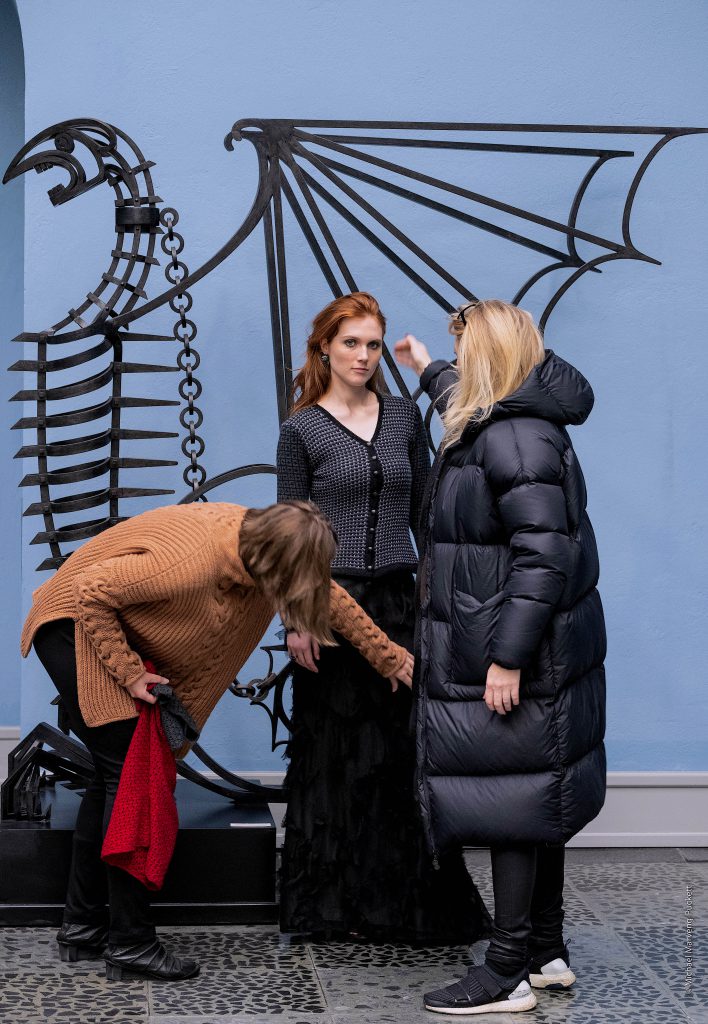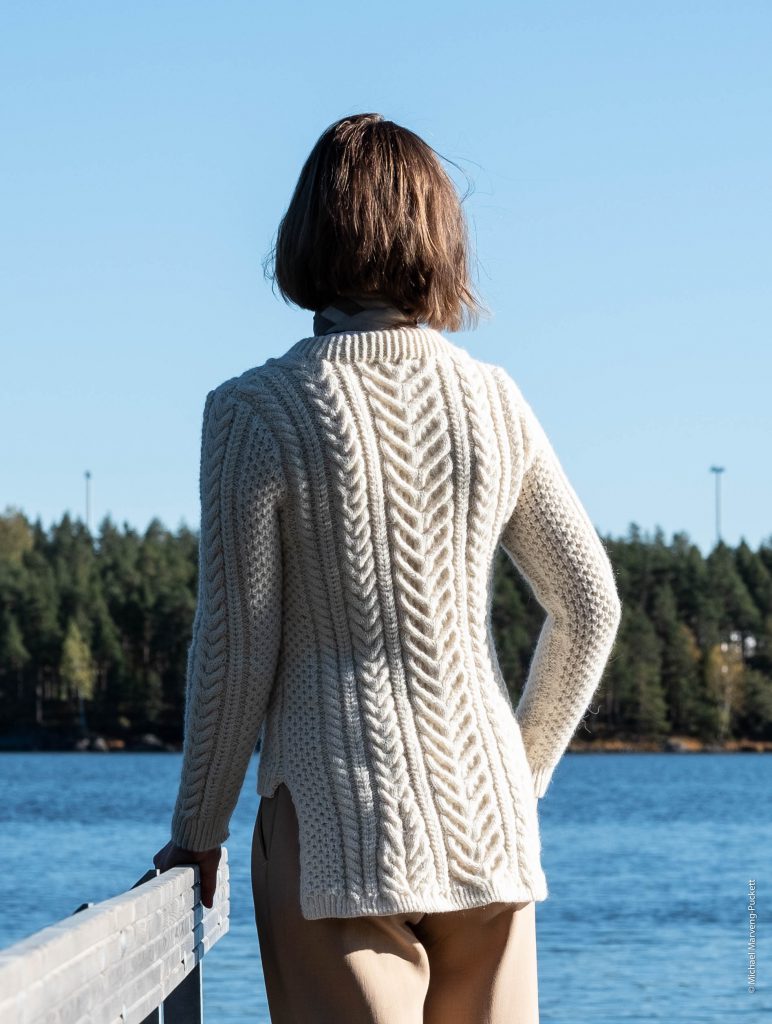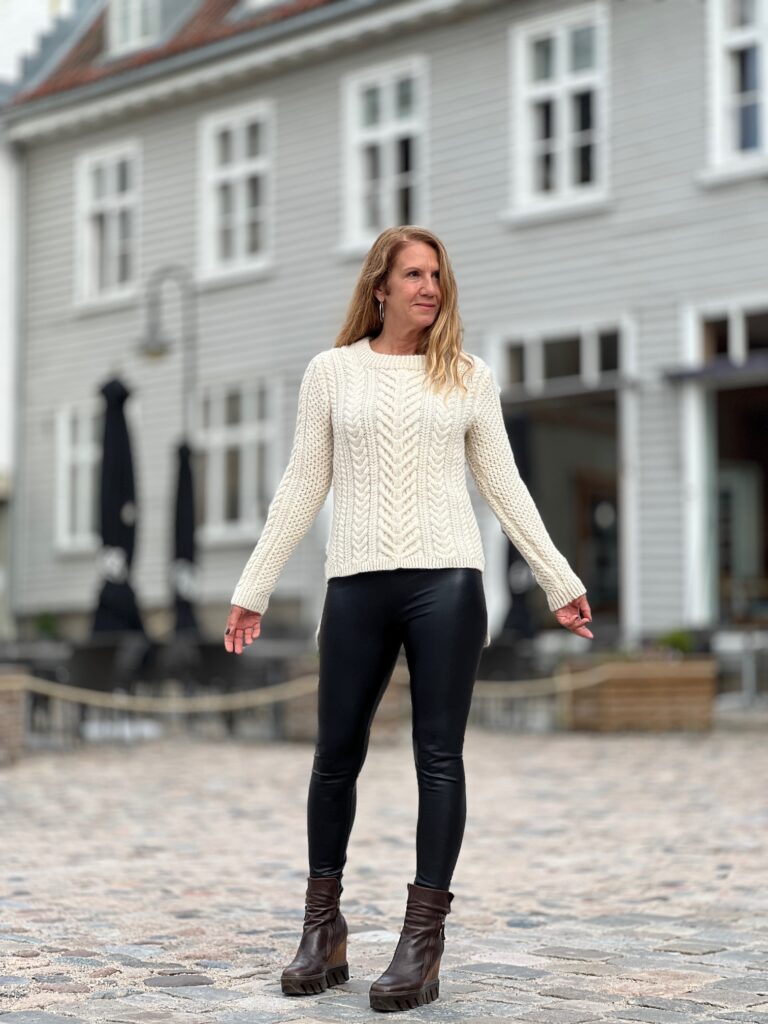 I am so thrilled to show you yet another brilliant set of photos of my old Nemetona design worn by my stunning friend Rebekah Audic, photographed by her husband Gael Audic in the old city of Fredrikstad. Continue reading
I am so thrilled to show you yet another brilliant set of photos of my old Nemetona design worn by my stunning friend Rebekah Audic, photographed by her husband Gael Audic in the old city of Fredrikstad. Continue reading
Tag Archives: Nemetona
NSF Knitting Weekend
 Every weekend is a knitting weekend for me, but the last one was special since I was at the annual meeting for the Norwegian Knitting Association – Norsk Strikkeforbund – at Scandic Oslo Airport Hotel at Gardermoen. I am not a member of the board but I am the editorial “team” for the digital membership magazine called “På pinnen“/On the Needle and work with editor designer & author Tove Fevang (standing talking to a new board member). We were about 60 knitters attending. It was a perfect opportunity to meet known and unknown knitters and I took the opportunity to have a stand to sell my printed patterns. The program for the weekend was filled with annual meeting, talks, workshops, knitting and chatting as well as delicious meals! Below you see part of my stand, next to Margrete Slettan, Villull aka britstrikkenerd shop & instagram and Jeanette & Jeanine Førland (with the ponytail), aka knitknotnine. Continue reading
Every weekend is a knitting weekend for me, but the last one was special since I was at the annual meeting for the Norwegian Knitting Association – Norsk Strikkeforbund – at Scandic Oslo Airport Hotel at Gardermoen. I am not a member of the board but I am the editorial “team” for the digital membership magazine called “På pinnen“/On the Needle and work with editor designer & author Tove Fevang (standing talking to a new board member). We were about 60 knitters attending. It was a perfect opportunity to meet known and unknown knitters and I took the opportunity to have a stand to sell my printed patterns. The program for the weekend was filled with annual meeting, talks, workshops, knitting and chatting as well as delicious meals! Below you see part of my stand, next to Margrete Slettan, Villull aka britstrikkenerd shop & instagram and Jeanette & Jeanine Førland (with the ponytail), aka knitknotnine. Continue reading
Strikkefestivalen in Fredrikstad 2019
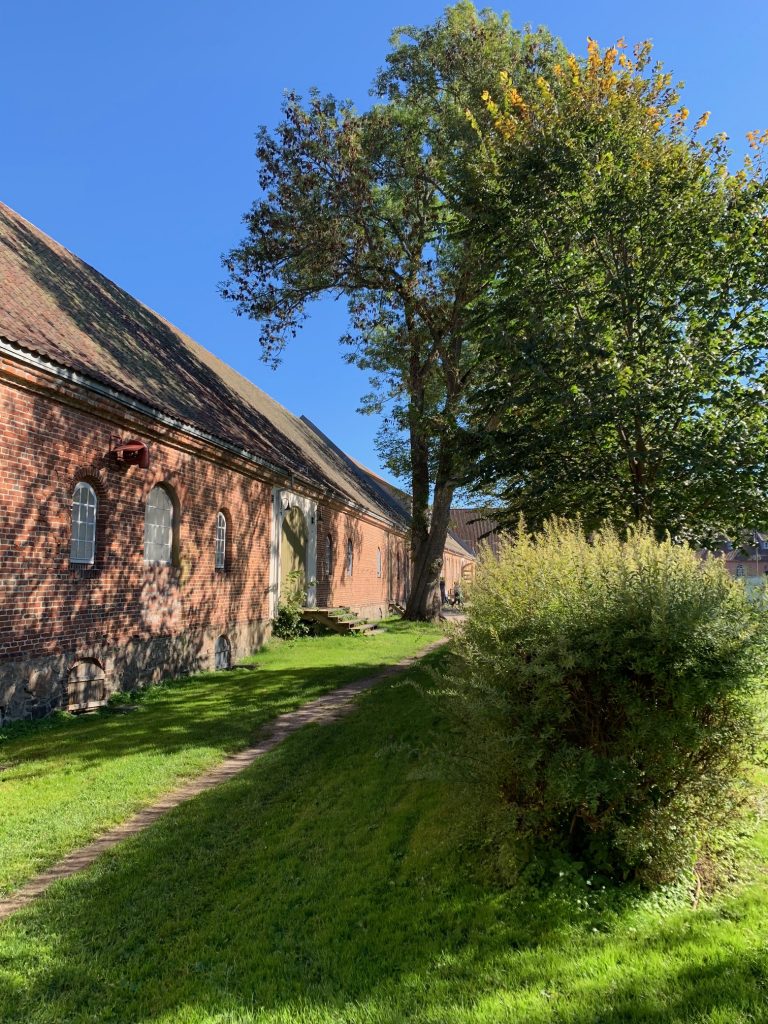 I have been back to the lovely Fredrikstad Old Town; the oldest fortified town in Norway (founded in 1567) and in the Nordic countries, and one of the best-preserved fortress towns in Northern Europe. The Strikkefestivalen/knitting festival is in its 4th year and still going very strong, run by four Knitting Motors: Marit Larsen, Lill Bjørnstad, Mette Bakken and Rita Walter together with numerous volunteers. They offer an impressive program with workshops, talks and including events such as “Knit & Poetry”, “Psalms & Knit” and “Knitting Cinema”. Above you see the courtyard surrounded by the museum, the market hall and the knit café, all held in these magnificent historic buildings dating back to 1775.
I have been back to the lovely Fredrikstad Old Town; the oldest fortified town in Norway (founded in 1567) and in the Nordic countries, and one of the best-preserved fortress towns in Northern Europe. The Strikkefestivalen/knitting festival is in its 4th year and still going very strong, run by four Knitting Motors: Marit Larsen, Lill Bjørnstad, Mette Bakken and Rita Walter together with numerous volunteers. They offer an impressive program with workshops, talks and including events such as “Knit & Poetry”, “Psalms & Knit” and “Knitting Cinema”. Above you see the courtyard surrounded by the museum, the market hall and the knit café, all held in these magnificent historic buildings dating back to 1775.
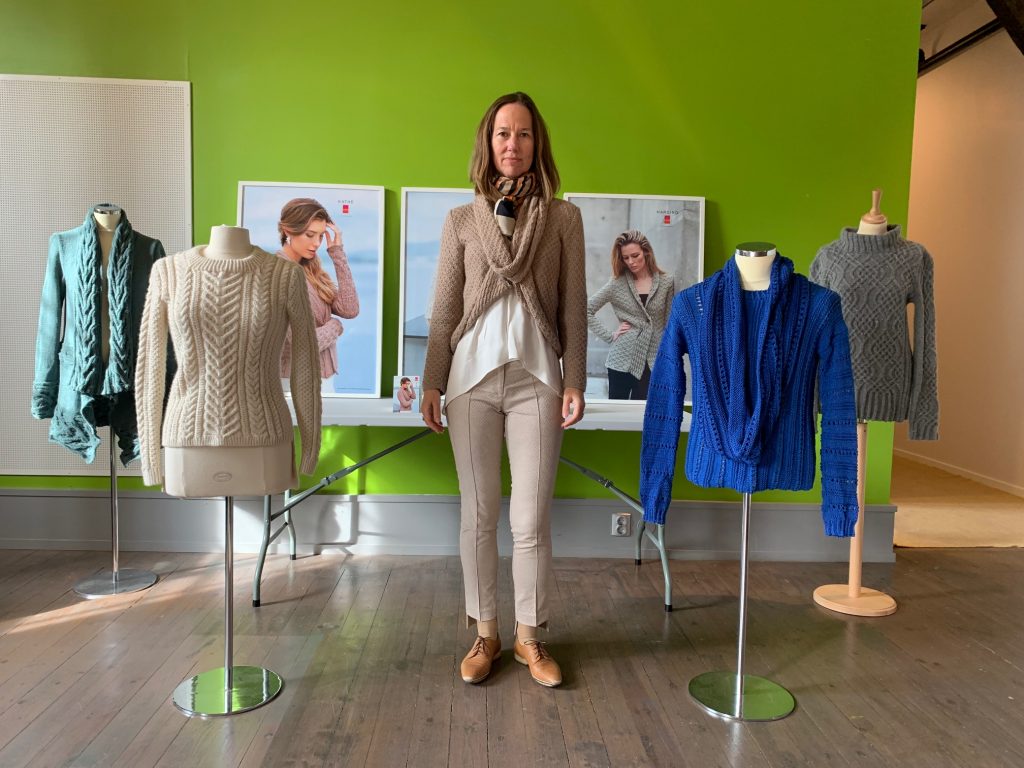 Michael and I went down to the Fredrikstad Museum on the day before the festival to mount my exhibition. Above you see a photo Michael took of me and my corner. I am wearing Aylwen next to my blue Vela, behind it is the grey Prescott Pullover. On my other side is the natural Nemetona and behind it the green Rørbye Cardigan. I used the opportunity to check if Makeløs – Remarkable Kristin Elise Halkjelsvik if she wanted to meet us for lunch at Café Magenta and she did! Read more about the café at the bottom. Indeed, she found me several times during the festival too and brought her husband to the Indian restaurant where designer Tove Fevang, Michael and I had our dinner on Friday night.
Michael and I went down to the Fredrikstad Museum on the day before the festival to mount my exhibition. Above you see a photo Michael took of me and my corner. I am wearing Aylwen next to my blue Vela, behind it is the grey Prescott Pullover. On my other side is the natural Nemetona and behind it the green Rørbye Cardigan. I used the opportunity to check if Makeløs – Remarkable Kristin Elise Halkjelsvik if she wanted to meet us for lunch at Café Magenta and she did! Read more about the café at the bottom. Indeed, she found me several times during the festival too and brought her husband to the Indian restaurant where designer Tove Fevang, Michael and I had our dinner on Friday night.
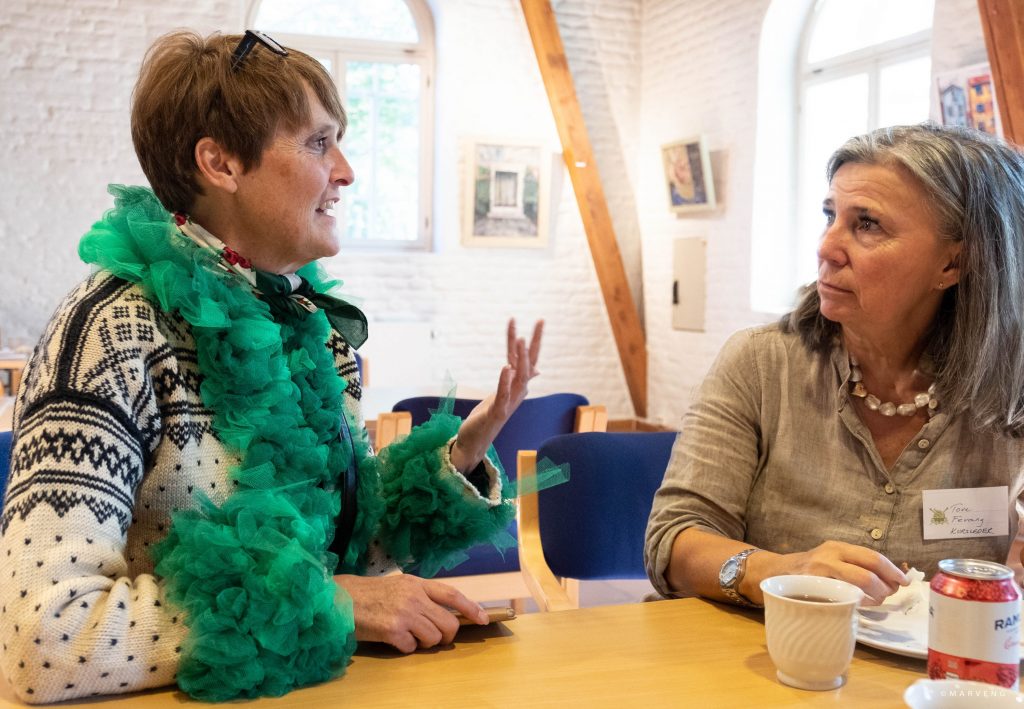 Lunchtime on Friday, Kristin found Tove and me having lunch at the knitting café. Kristin is a culture stylist and her outfits are magnificent and combines stylish elements with bright splashes of colour here made of tulle around the neckband plus cuffs of this otherwise traditional Setesdal Inspired Kofte (read: stranded colorwork jacket with traditional borders from the Setesdal Valley). Michael captured them better than I did.
Lunchtime on Friday, Kristin found Tove and me having lunch at the knitting café. Kristin is a culture stylist and her outfits are magnificent and combines stylish elements with bright splashes of colour here made of tulle around the neckband plus cuffs of this otherwise traditional Setesdal Inspired Kofte (read: stranded colorwork jacket with traditional borders from the Setesdal Valley). Michael captured them better than I did.
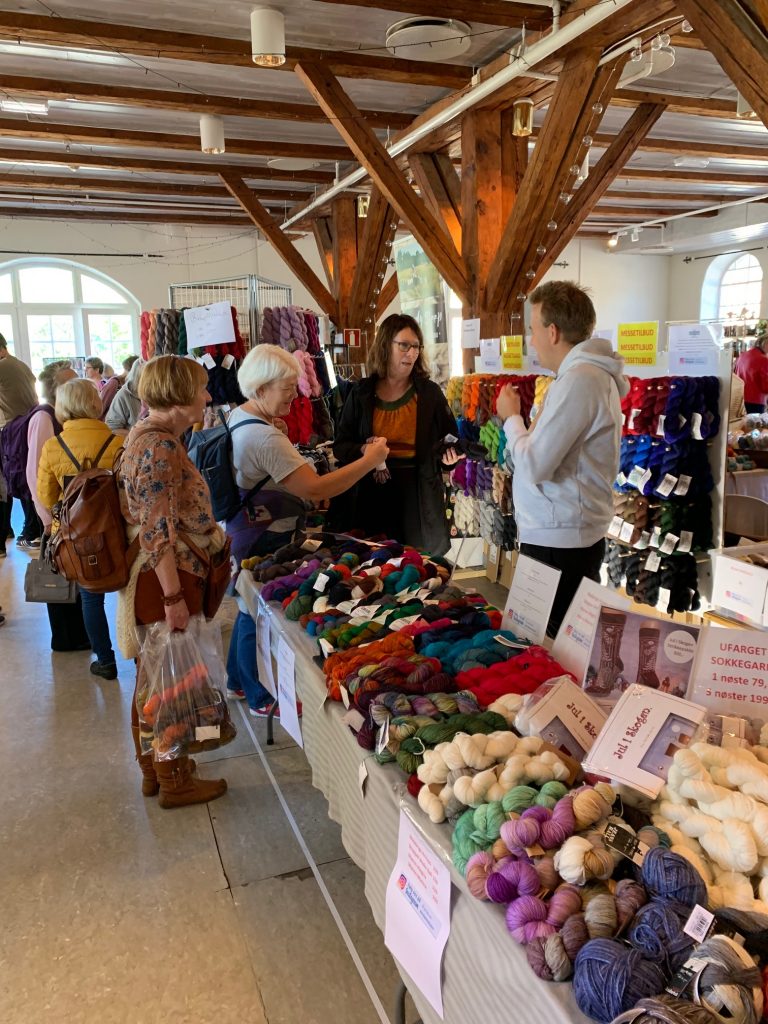 I held two workshops on Friday: Flettestrikk Masterclass/Cable Knitting Masterclass and Engelske Mønstre/English Patterns. Luckily, I met both knitters I knew from previously but also knitters I had not met earlier! Above is three of them yarn shopping at the Projo stand.
I held two workshops on Friday: Flettestrikk Masterclass/Cable Knitting Masterclass and Engelske Mønstre/English Patterns. Luckily, I met both knitters I knew from previously but also knitters I had not met earlier! Above is three of them yarn shopping at the Projo stand.
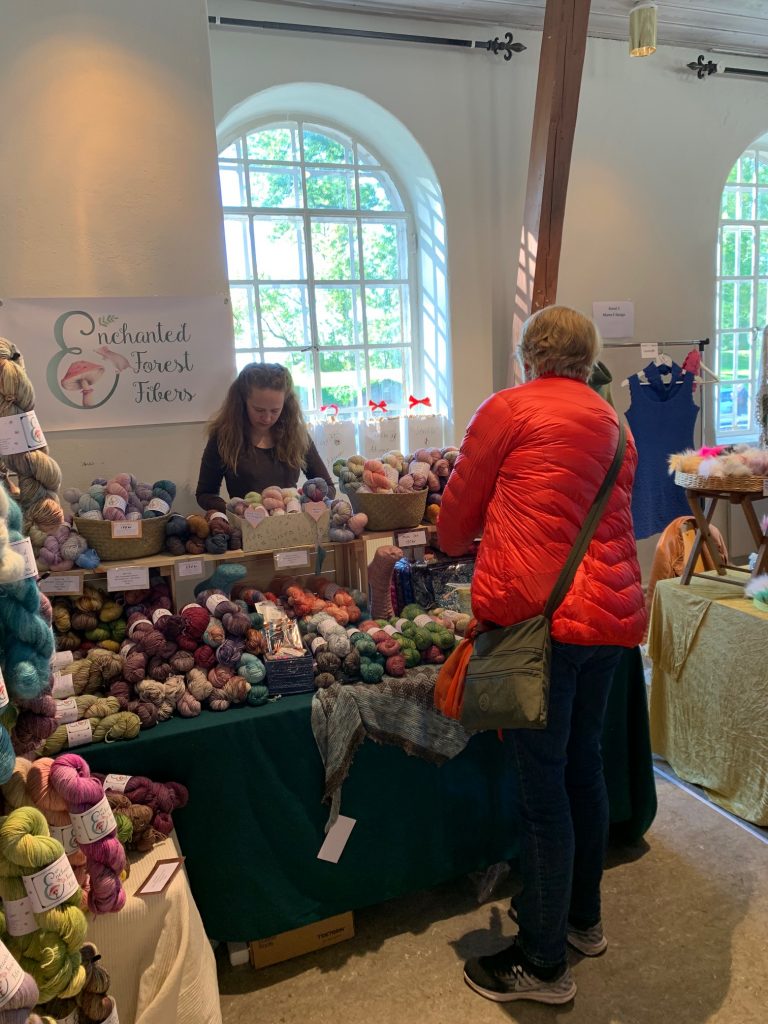 Of course I also had a chat with the other designers present: Tove Fevang, Helle Siggerud, Denise Samson, Kari Hestens and Annemor Sundbø – the Norwegian knitting legend.
Of course I also had a chat with the other designers present: Tove Fevang, Helle Siggerud, Denise Samson, Kari Hestens and Annemor Sundbø – the Norwegian knitting legend.
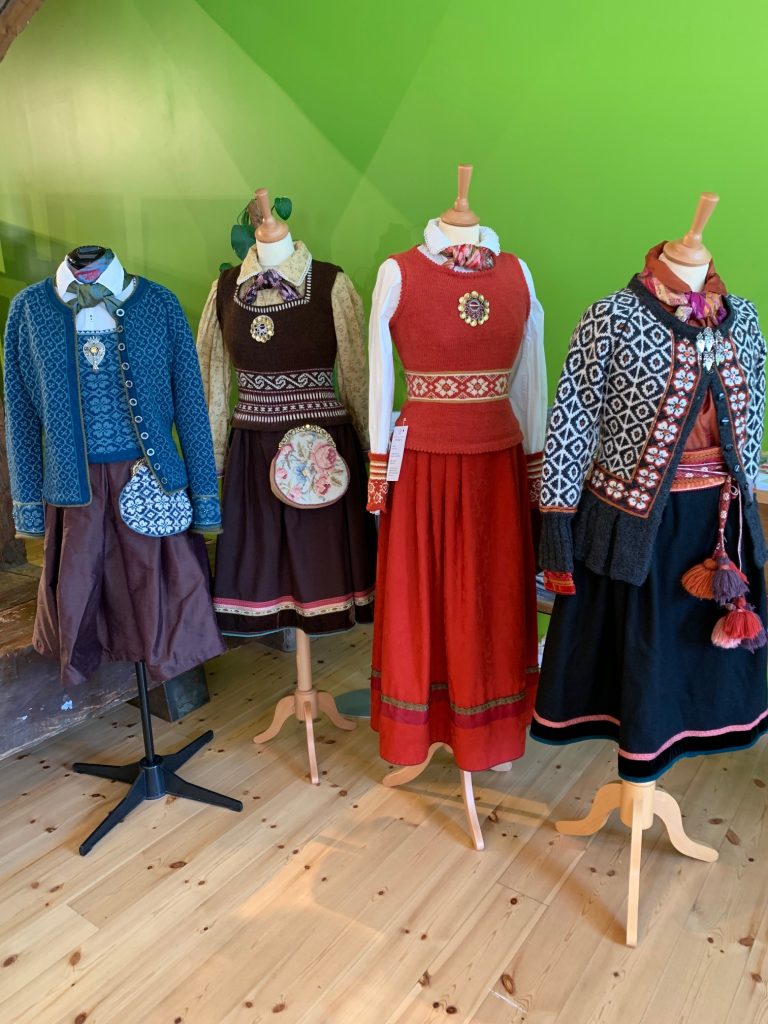 Just like me, Helle Siggerud also had an exhibition in another corner of Fredrikstad Museum. Unlike me, Helle is a sewer and have designed all these lovely outfits, inspired by our national costumes. Yes, Helle also sews national costumes, see more on her webpage: Helles Syskrin.
Just like me, Helle Siggerud also had an exhibition in another corner of Fredrikstad Museum. Unlike me, Helle is a sewer and have designed all these lovely outfits, inspired by our national costumes. Yes, Helle also sews national costumes, see more on her webpage: Helles Syskrin.
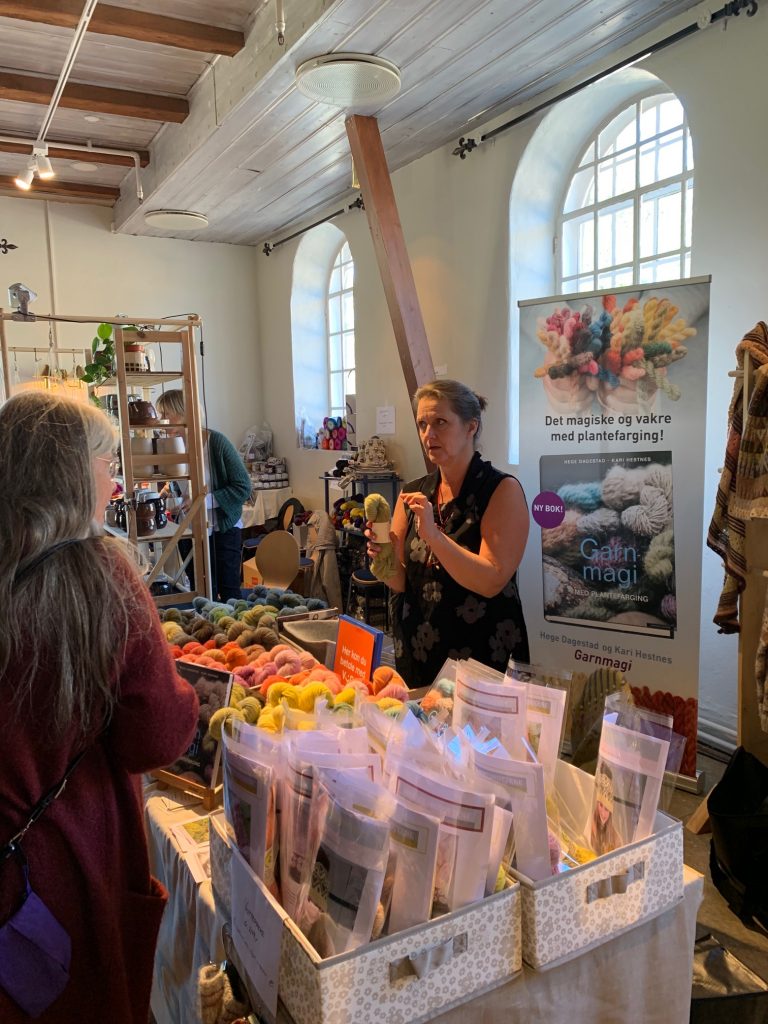 Yarn dyer Hege Dagestad was there – see above – and so was Karen Walthinsen of Enchanted Forest Fibers, who I had not met before. Below is another yarn photo, as I know I cannot include too many of those for you to look at.
Yarn dyer Hege Dagestad was there – see above – and so was Karen Walthinsen of Enchanted Forest Fibers, who I had not met before. Below is another yarn photo, as I know I cannot include too many of those for you to look at.
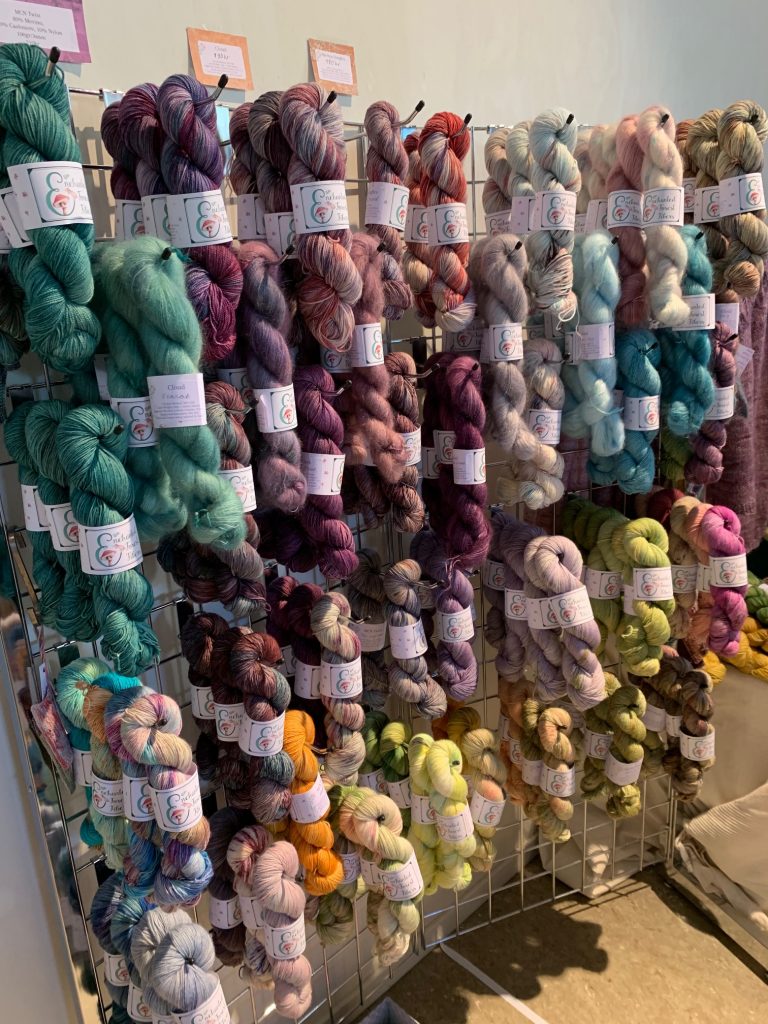 Below is a photo Michael took of Tove and me checking out the stands. I am wearing my Aife knitted in the gorgeous hand dyed Dye Dye Done, Pure Sport and it is currently being test knitted before I release the pattern in English and Norwegian on Ravelry and Love Crafts.
Below is a photo Michael took of Tove and me checking out the stands. I am wearing my Aife knitted in the gorgeous hand dyed Dye Dye Done, Pure Sport and it is currently being test knitted before I release the pattern in English and Norwegian on Ravelry and Love Crafts.
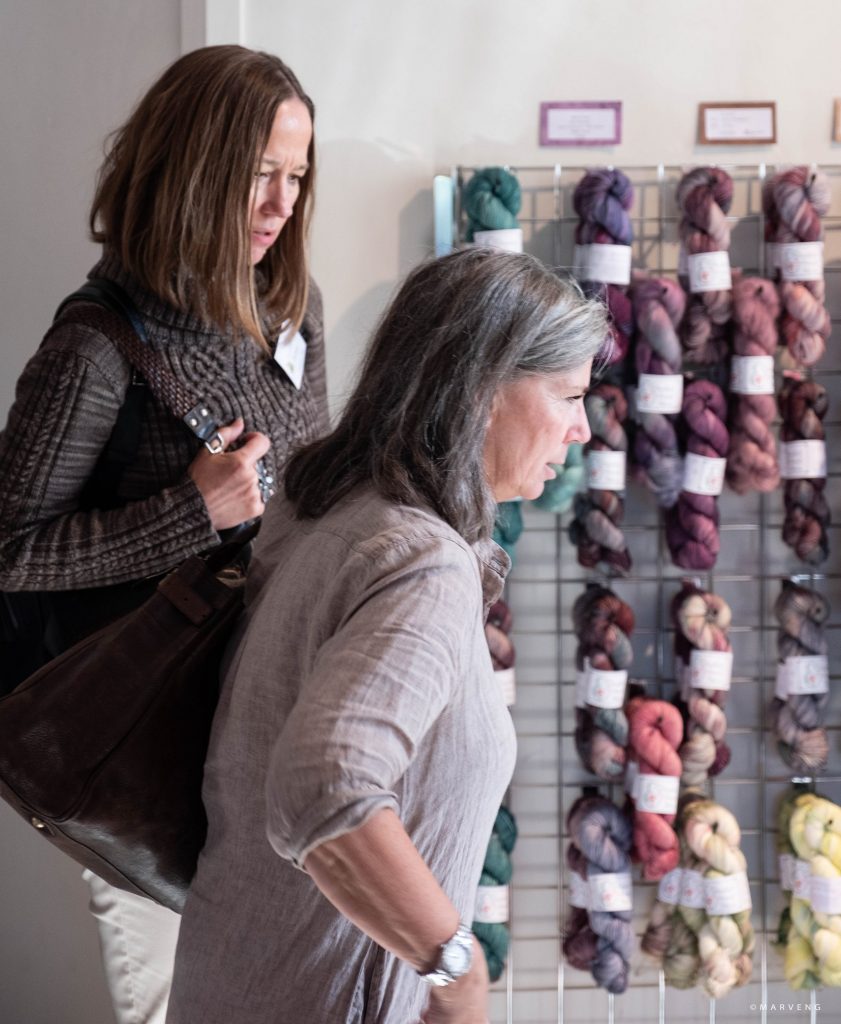 I took the other photos above on Saturday morning before the Market Hall became too full and before my third workshop. The festival had booked all the workshops holders into the same hotel so we all met up for breakfast on Saturday morning. That was a nice treat.
I took the other photos above on Saturday morning before the Market Hall became too full and before my third workshop. The festival had booked all the workshops holders into the same hotel so we all met up for breakfast on Saturday morning. That was a nice treat.
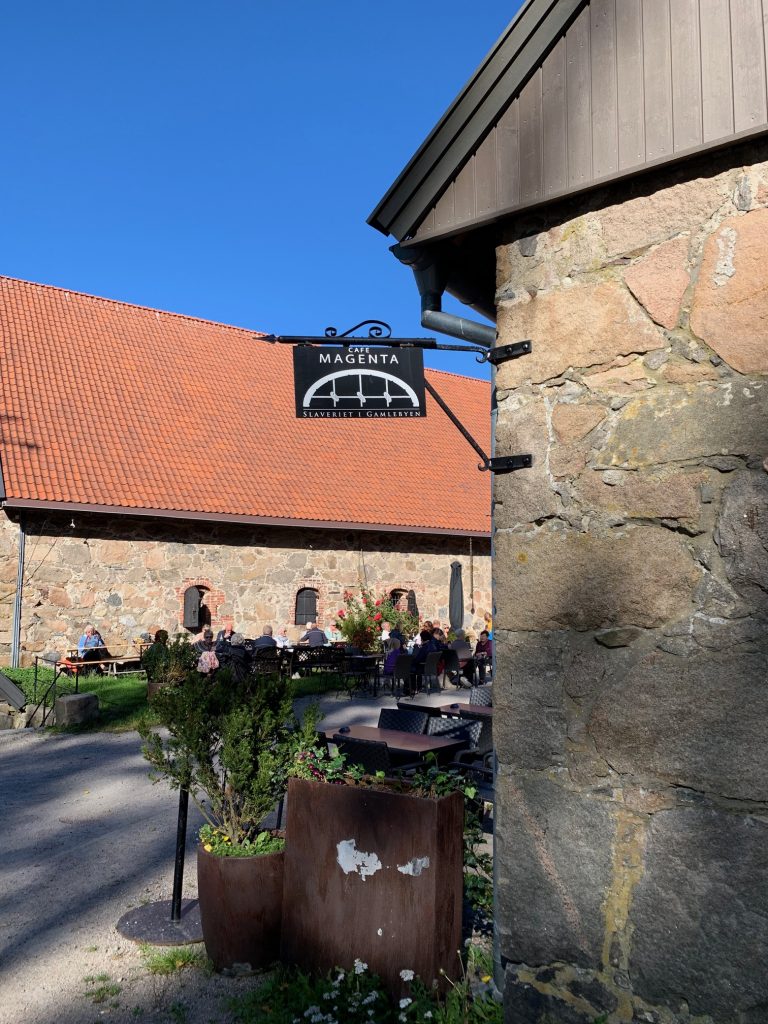 Above is the sign and the outdoor seating for my favourite coffee shop in the Old City, Café Magenta – where the captives of the fortress were held back in 1731. The owners have come to love the knitting festival. Back in 2016, they had no idea what caused the invasion (of mainly female vistitors that is) during the first knitting festival. This year they were prepared and their meny was found printed to take away, inside in the Market Hall.
Above is the sign and the outdoor seating for my favourite coffee shop in the Old City, Café Magenta – where the captives of the fortress were held back in 1731. The owners have come to love the knitting festival. Back in 2016, they had no idea what caused the invasion (of mainly female vistitors that is) during the first knitting festival. This year they were prepared and their meny was found printed to take away, inside in the Market Hall.
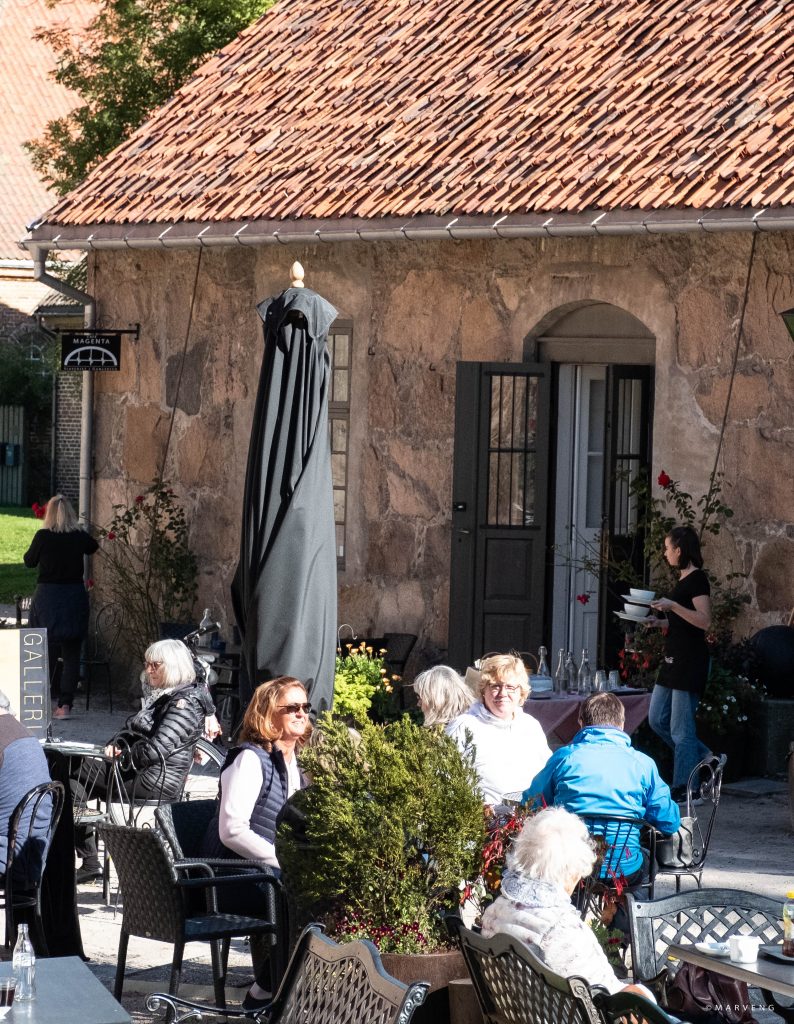 After my workshop on Saturday from 3 to 6 PM, Michael and I drove home. While I was finishing up my workshop, Michael dismounted my exhibition. I had a fab time, as always! Thank you to the organisers, to all the knitters I met and all my designer friends!
After my workshop on Saturday from 3 to 6 PM, Michael and I drove home. While I was finishing up my workshop, Michael dismounted my exhibition. I had a fab time, as always! Thank you to the organisers, to all the knitters I met and all my designer friends!
Høststrikk 2019 with Rørbye Cardigan and Nemetona
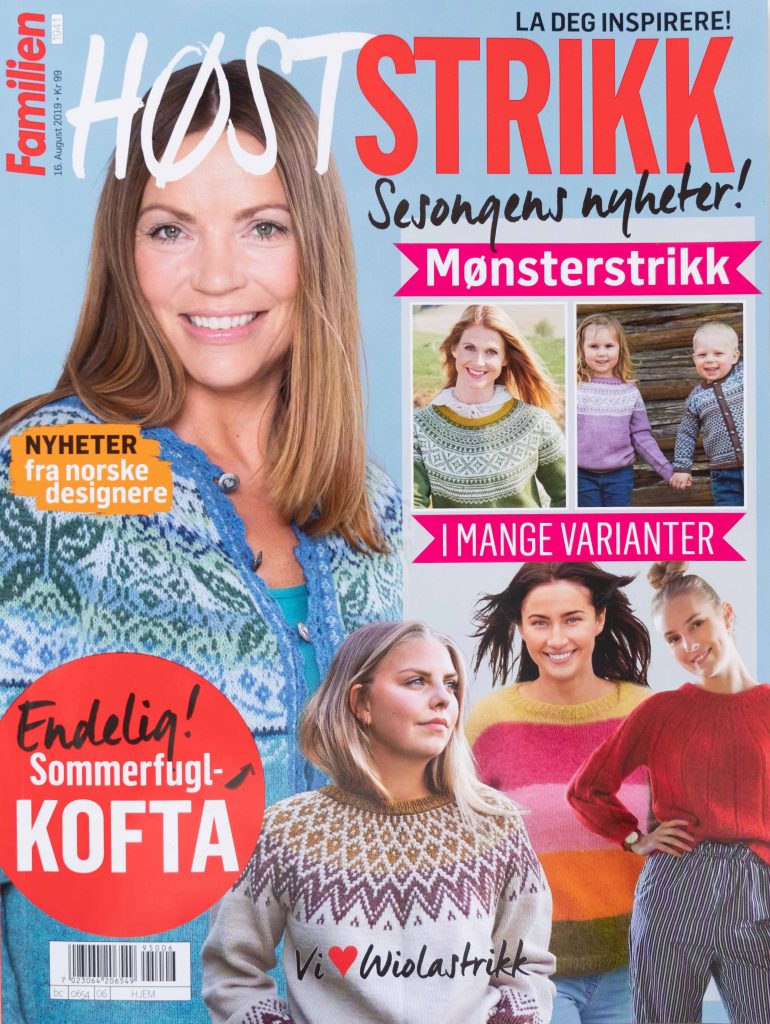 The Norwegian special magazine Høststrikk/Autumn Knits published by Familien is on sale and I am delighted to have two patterns inside it: Rørbye Cardigan and Nemetona. The magazines is filled with knitting patterns for all ages, but mainly for women as you can see from the cover. My Rørbye Cardigan modelled by Emma Ross, with hair & make up by Sissel Fylling and jewellery by Kaja Gjedebo Design, photographed by Eivind Røhne at the Vigeland Museum, is one of four designs on the back cover as well as on the editorial page.
The Norwegian special magazine Høststrikk/Autumn Knits published by Familien is on sale and I am delighted to have two patterns inside it: Rørbye Cardigan and Nemetona. The magazines is filled with knitting patterns for all ages, but mainly for women as you can see from the cover. My Rørbye Cardigan modelled by Emma Ross, with hair & make up by Sissel Fylling and jewellery by Kaja Gjedebo Design, photographed by Eivind Røhne at the Vigeland Museum, is one of four designs on the back cover as well as on the editorial page.
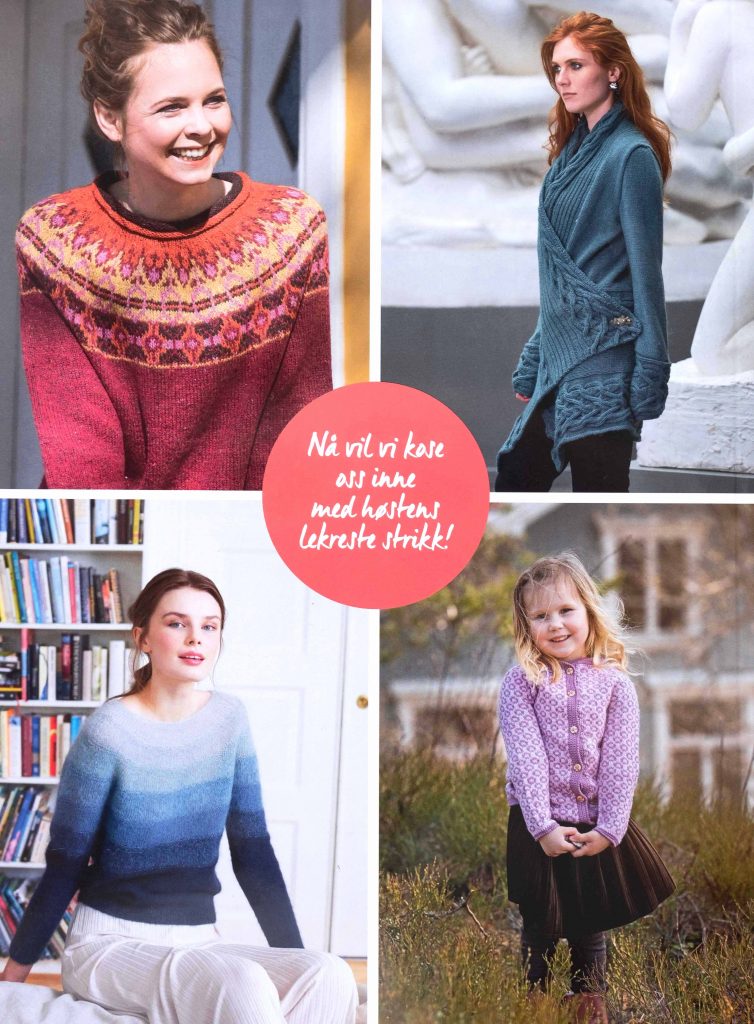 Here is the back cover, with the Rørbye Cardigan at the top, next to a design by Golden Days by Kari Hestnes. The jacket was made for Interweave knit.wear Fall/Winter 2017 and is knitted in Dale Eco Wool using 4 mm/US 6 needles. Here is my introduction: A classy and sophisticated knitted cardigan in a contemporary style. The waterfall bottom is created by knitting a sideways cable panel. To offset the cables, the body is all in stockinette stitch, with the exception of the cuff. Each sleeve begins in a sideways knitted cable panel. Leave it open, or pin the cardigan together at the front or in the side, if you prefer to wrap it all around you.
Here is the back cover, with the Rørbye Cardigan at the top, next to a design by Golden Days by Kari Hestnes. The jacket was made for Interweave knit.wear Fall/Winter 2017 and is knitted in Dale Eco Wool using 4 mm/US 6 needles. Here is my introduction: A classy and sophisticated knitted cardigan in a contemporary style. The waterfall bottom is created by knitting a sideways cable panel. To offset the cables, the body is all in stockinette stitch, with the exception of the cuff. Each sleeve begins in a sideways knitted cable panel. Leave it open, or pin the cardigan together at the front or in the side, if you prefer to wrap it all around you.
 Nemetona is featured inside the magazine at the beginning of my pages called “Fantastic Cables”. I do love the introduction: “Designer Linda Marveng is an expert on cable knitting. Here are two gorgeous designs photo grated on Emma Ross at the Vigeland Museum in Oslo.”
Nemetona is featured inside the magazine at the beginning of my pages called “Fantastic Cables”. I do love the introduction: “Designer Linda Marveng is an expert on cable knitting. Here are two gorgeous designs photo grated on Emma Ross at the Vigeland Museum in Oslo.”
 Nemetona is Celtic for goddess of all sacred places. Like a magical cable grove is each part of this pullover: Staghorn, Roman; and double cables are framed by Honeycomb pattern. The flowing longer back with its curved hem, creates a stylish contrast to the straight front. Nemetona is knitted in pieces in the divine The Fibre Co. Cumbria.
Nemetona is Celtic for goddess of all sacred places. Like a magical cable grove is each part of this pullover: Staghorn, Roman; and double cables are framed by Honeycomb pattern. The flowing longer back with its curved hem, creates a stylish contrast to the straight front. Nemetona is knitted in pieces in the divine The Fibre Co. Cumbria.
The Familien Høststrikk magazine is available at selected news agents and super markets. If you are in Norway you can buy a digital version for iPad, see www.klikk.no. If you live abroad you can order the Norwegian special magazine by e-mailing kari.bachke@egmont.com and then transfer payment into their bank account.
Nemetona Knitted by Siret
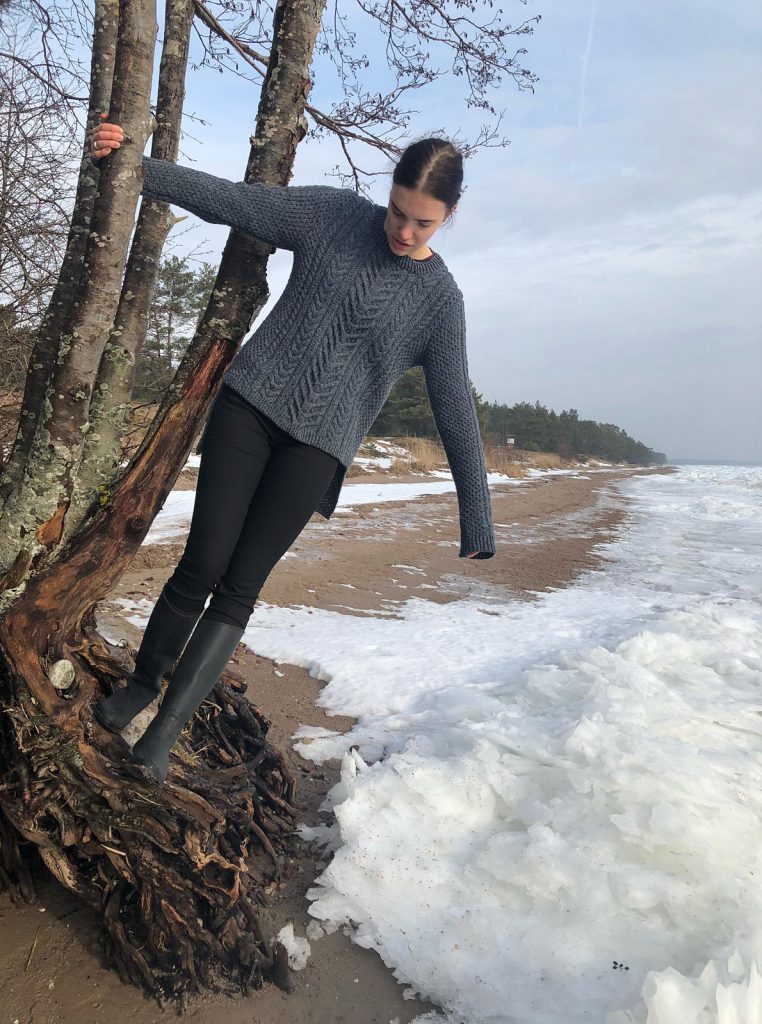 I am so thrilled to be able to share the wonderful photos taken by Siret of her daughter wearing the Nemetona pullover at Mändjala Beach at the island of Saaremaa in Estonia. Siret, aka kollane on Ravelry, took part in the test knit of Nemetona and made size Large for herself initially, that is, since her daughter wanted it after their photoshoot. So now it belongs to her daughter. Her pullover is knitted in Rowan Cashmere Tweed in the shade of Granite using a 4 mm/US 6 needle and a 20 stitches and 28 rows gauge per 10 cm/4″ square.
I am so thrilled to be able to share the wonderful photos taken by Siret of her daughter wearing the Nemetona pullover at Mändjala Beach at the island of Saaremaa in Estonia. Siret, aka kollane on Ravelry, took part in the test knit of Nemetona and made size Large for herself initially, that is, since her daughter wanted it after their photoshoot. So now it belongs to her daughter. Her pullover is knitted in Rowan Cashmere Tweed in the shade of Granite using a 4 mm/US 6 needle and a 20 stitches and 28 rows gauge per 10 cm/4″ square.
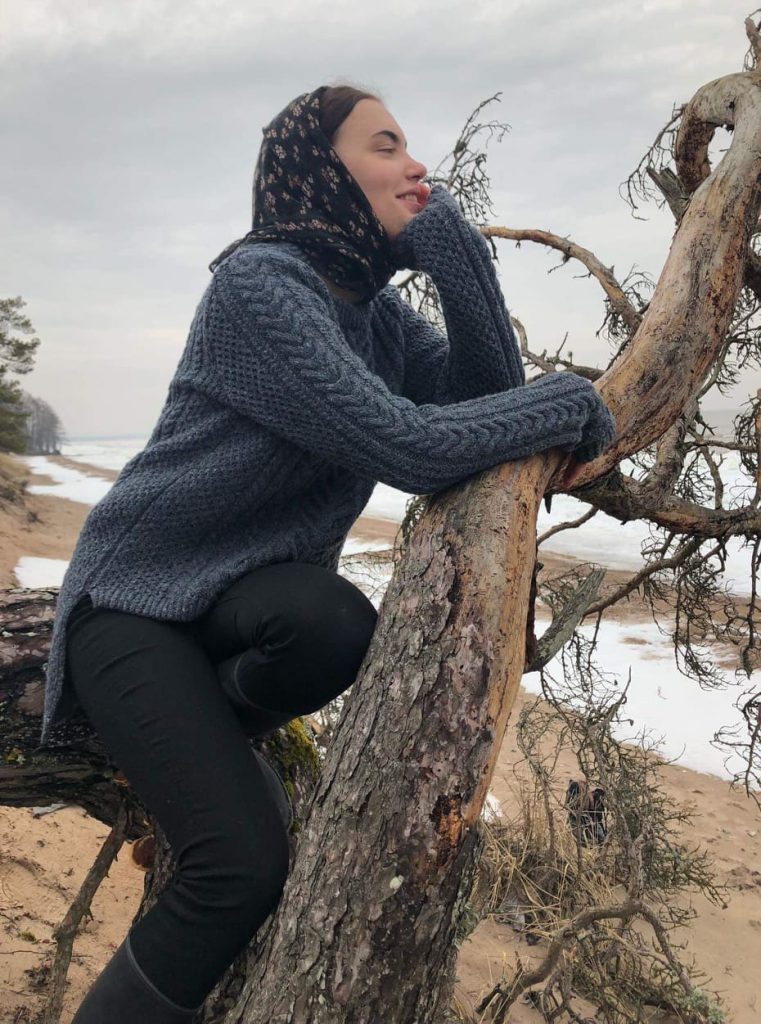 Siret writes on her project page: “Rowan Cashmere Tweed is surprisingly good yarn for knitting cables. For a small and dense cable like the Roman cable, this yarn is too soft – the twists are not so clear. But amazing for the bigger ones.” She also recommend not using it for seaming as it breaks easily. I do love the finished look and how stunning it looks!
Siret writes on her project page: “Rowan Cashmere Tweed is surprisingly good yarn for knitting cables. For a small and dense cable like the Roman cable, this yarn is too soft – the twists are not so clear. But amazing for the bigger ones.” She also recommend not using it for seaming as it breaks easily. I do love the finished look and how stunning it looks!
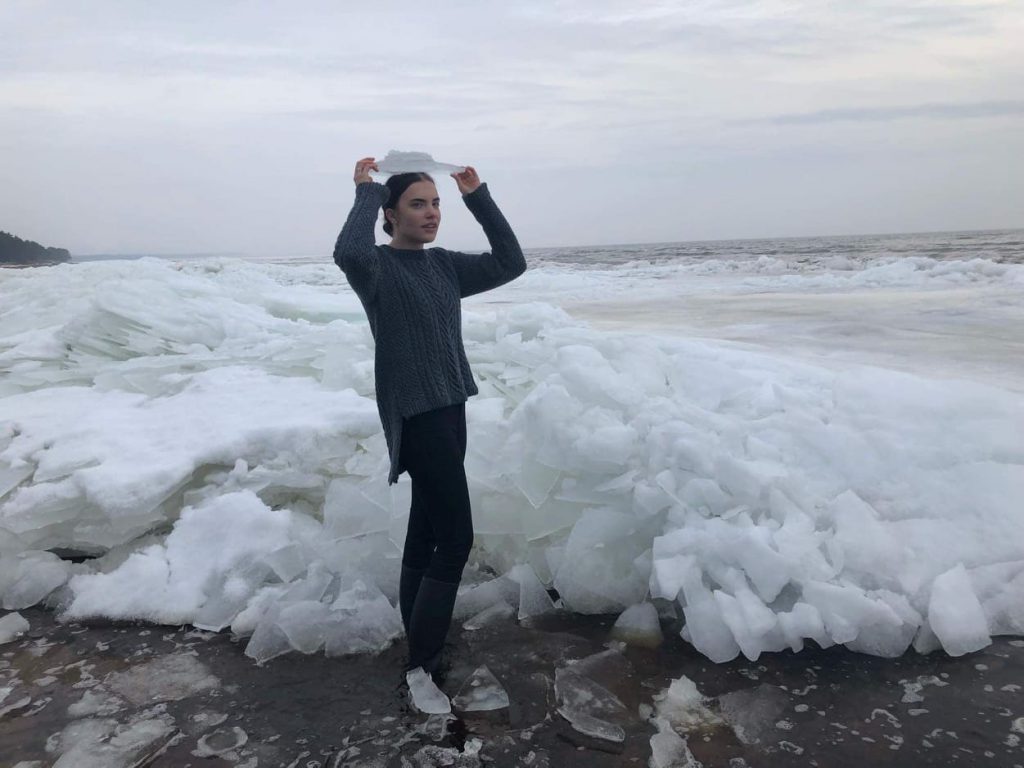 I could not resist including this photo too, since all the broken ice is so dramatic and trying to balance a piece of ice on one’s head does look funny. Siret had not planned to take part in the test knit according to her project page: “I thought I was not taking part in the Nemetona pullover test, I wanted to finish my Prescott before the new project, but …
I could not resist including this photo too, since all the broken ice is so dramatic and trying to balance a piece of ice on one’s head does look funny. Siret had not planned to take part in the test knit according to her project page: “I thought I was not taking part in the Nemetona pullover test, I wanted to finish my Prescott before the new project, but …
But how can you resist the possibility of putting yourself to the test with such powerful cables, very interesting shorter front and longer back?” I am so grateful she could not resist it!
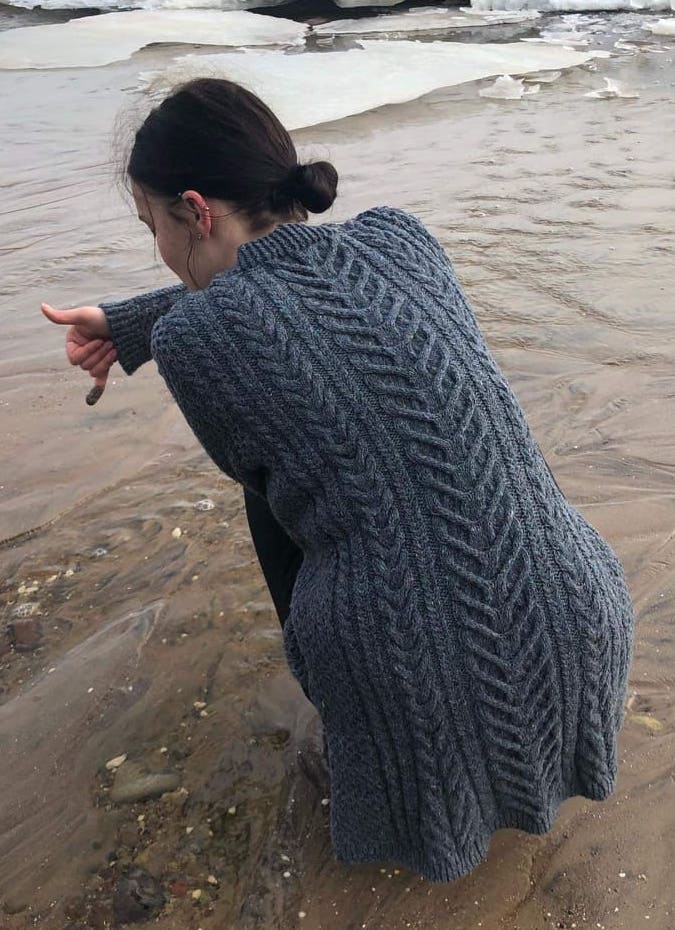 Finally, I want to share a photo of the back taken at the beach shore! Thank you ever so much for taking part in the test knit, Siret and for taking this stunning photos of your daughter!
Finally, I want to share a photo of the back taken at the beach shore! Thank you ever so much for taking part in the test knit, Siret and for taking this stunning photos of your daughter!
Here is my introduction to the pattern: Nemetona is Celtic for goddess of all sacred places. Like a magical cable grove is each part of this pullover: Staghorn, Roman; and double cables are framed by Honeycomb pattern. The flowing longer back with its curved hem, creates a stylish contrast to the straight front. Nemetona is knitted in pieces in the divine The Fibre Co. Cumbria.
Nemetona is available as a digital download in English, in sizes XS to 2XL with a bust circumference of 84 to 126 cm/33 to 49.5″, in my Ravelry Store and on Loveknitting. The Norwegian pattern will be published in the Norwegian magazine Familien at a later date.
Photoshoot at Vigeland Museum: Nemetona
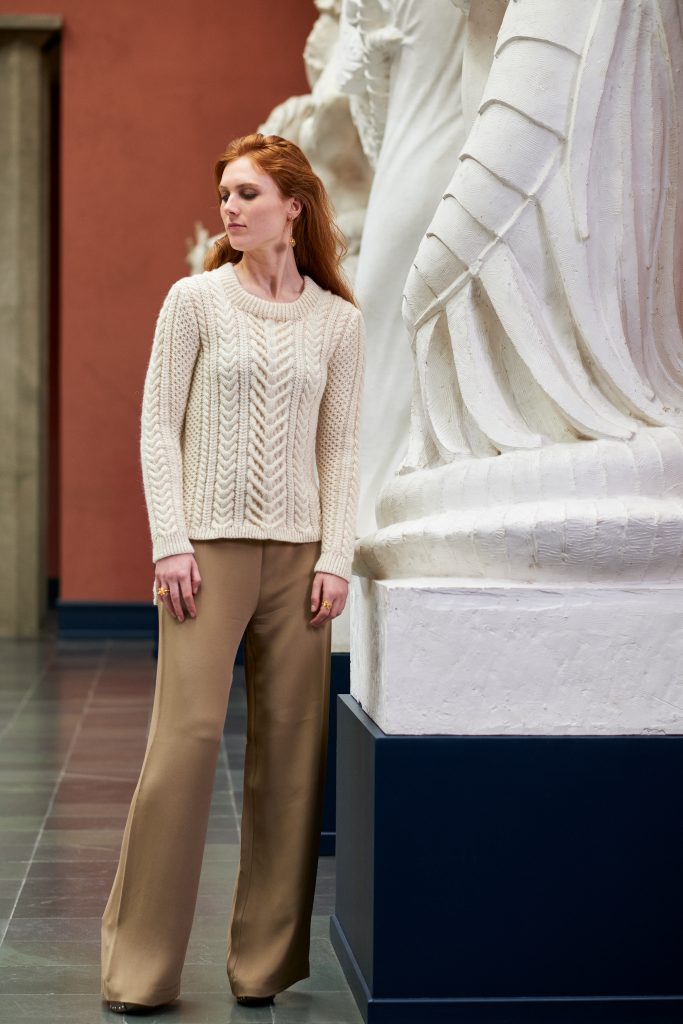 I have been looking forward to sharing the amazing photos Eivind Røhne took of gorgeous model Emma Ross, with hair & makeup by Sissel Fylling and jewellery by Kaja Gjedebo Design at the Vigeland Museum, next to the Vigeland Park in Oslo in November last year. The brick building in Norwegian Neo Classical style from the 1920’s does not look especially impressive from the outside, but I can promise you that the inside will blow you away. Not only because of all the sculptures but also because of the majestic ceiling height. “The museum is the result of a unique contract between Gustav Vigeland and the city of Oslo signed in 1921: The Municipality agreed to build a studio, residence and future museum for the artist and his work, and in return Vigeland donated nearly all his works, previous and future, to the city”. This year the Vigeland Museum celebrates that it is 150 years since the artist was born. What better occasion to start presenting these photos. First out is my new design Nemetona, since the test knit begins on Monday on Ravelry.
I have been looking forward to sharing the amazing photos Eivind Røhne took of gorgeous model Emma Ross, with hair & makeup by Sissel Fylling and jewellery by Kaja Gjedebo Design at the Vigeland Museum, next to the Vigeland Park in Oslo in November last year. The brick building in Norwegian Neo Classical style from the 1920’s does not look especially impressive from the outside, but I can promise you that the inside will blow you away. Not only because of all the sculptures but also because of the majestic ceiling height. “The museum is the result of a unique contract between Gustav Vigeland and the city of Oslo signed in 1921: The Municipality agreed to build a studio, residence and future museum for the artist and his work, and in return Vigeland donated nearly all his works, previous and future, to the city”. This year the Vigeland Museum celebrates that it is 150 years since the artist was born. What better occasion to start presenting these photos. First out is my new design Nemetona, since the test knit begins on Monday on Ravelry.
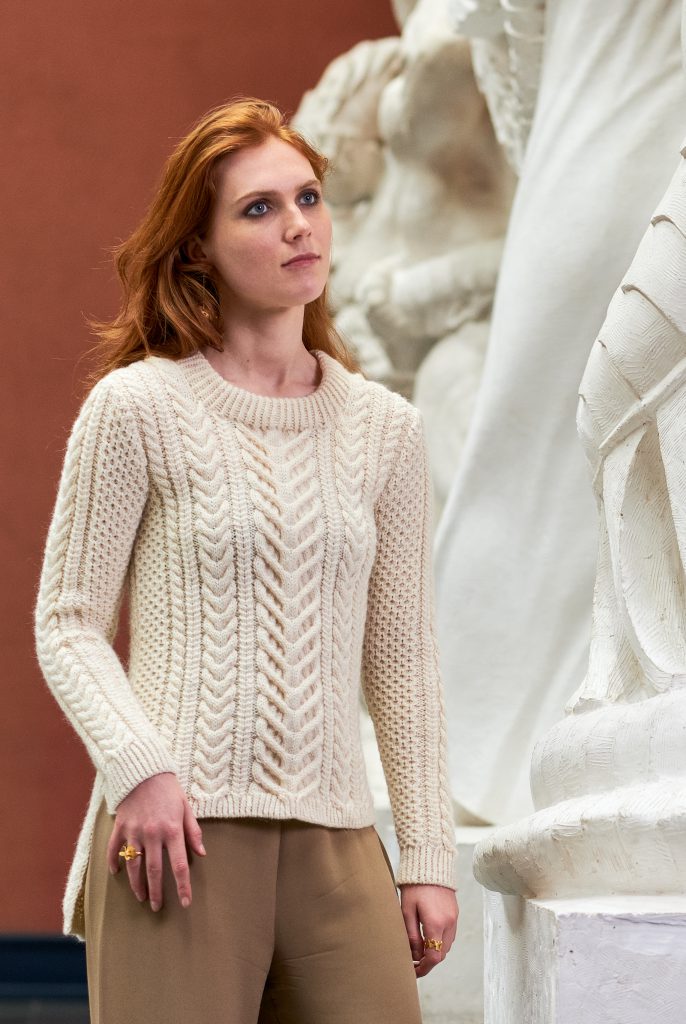 Nemetona is Celtic for goddess of all sacred places. Like a magical cable grove is each part of this pullover: Staghorn, Roman; and double cables are framed by Honeycomb pattern. The flowing longer back with its curved hem, creates a stylish contrast to the straight front. Nemetona is knitted in pieces in the divine The Fibre Co. Cumbria using 4 mm/US 6 needles and 3.5 mm/US 4 needles with a gauge of 20 stitches and 28 rows in stockinette stitch measures 10 cm/4″ square.
Nemetona is Celtic for goddess of all sacred places. Like a magical cable grove is each part of this pullover: Staghorn, Roman; and double cables are framed by Honeycomb pattern. The flowing longer back with its curved hem, creates a stylish contrast to the straight front. Nemetona is knitted in pieces in the divine The Fibre Co. Cumbria using 4 mm/US 6 needles and 3.5 mm/US 4 needles with a gauge of 20 stitches and 28 rows in stockinette stitch measures 10 cm/4″ square.
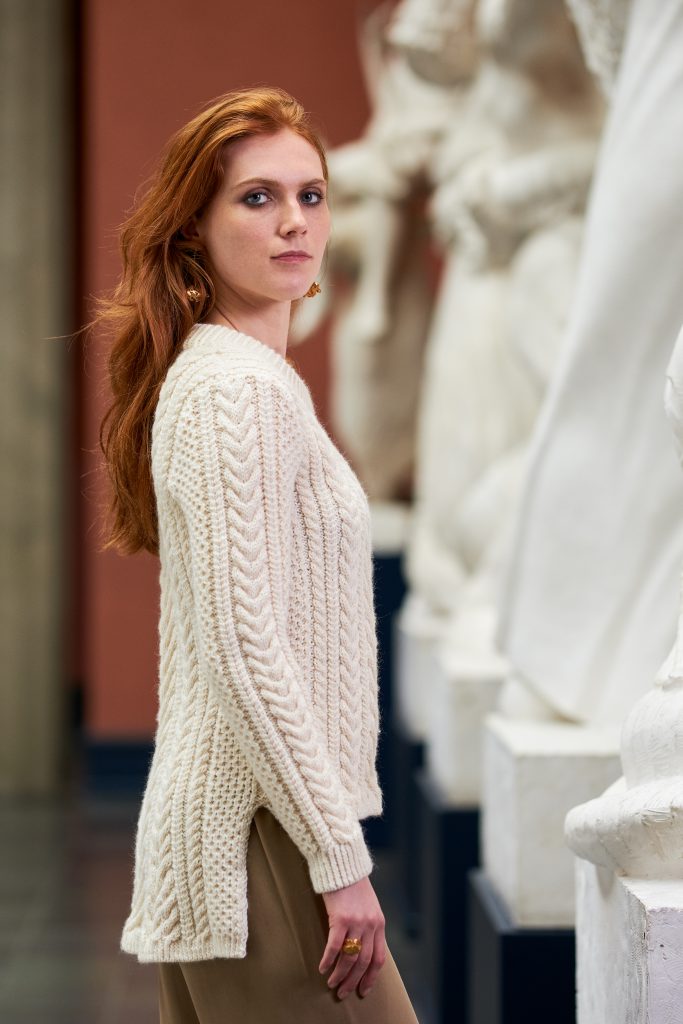 Em is wearing size small, while the pullover is graded from size XS to 2XL with a bust circumference of 84 to 126 cm/33 to 49.5″. I chose to style it with some tan coloured silk trousers, after asking for Sissel’s advice. In additon I had also brought the same trousers in cream and one of dress designer Judith Bech’s cream coloured long skirts with a train, because I had not made up my mind before we left for Oslo and the museum.
Em is wearing size small, while the pullover is graded from size XS to 2XL with a bust circumference of 84 to 126 cm/33 to 49.5″. I chose to style it with some tan coloured silk trousers, after asking for Sissel’s advice. In additon I had also brought the same trousers in cream and one of dress designer Judith Bech’s cream coloured long skirts with a train, because I had not made up my mind before we left for Oslo and the museum.
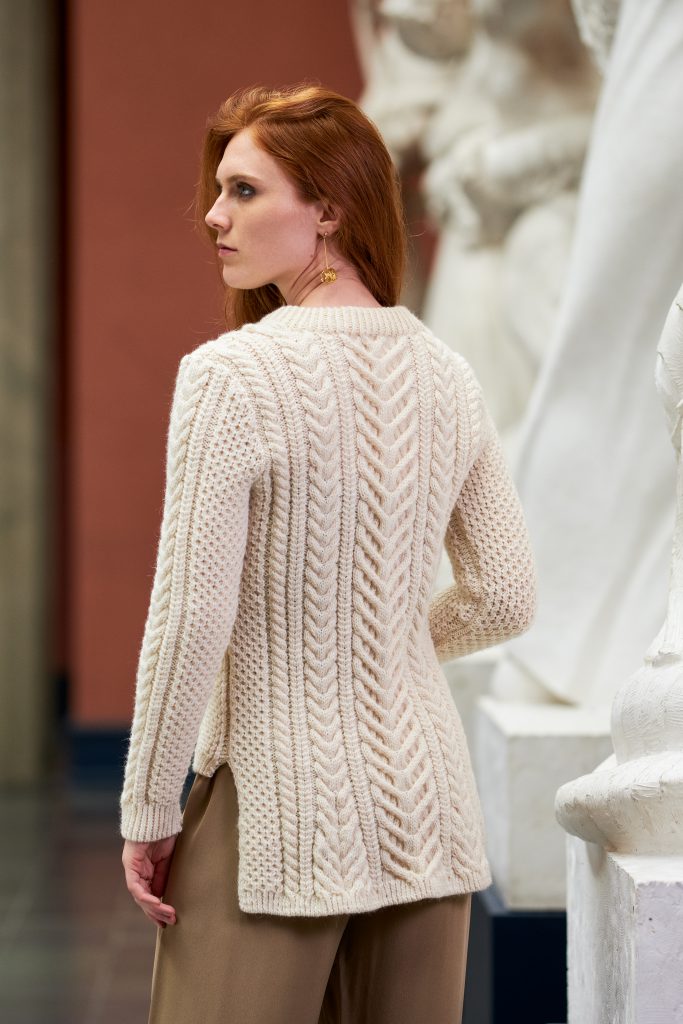 The sweater is knitted back and forth in pieces and then seamed. The neckband is worked in the round, double and folded down. The longer back has decreases in the double cable at the bottom. The vent edges are made with slipped stitches.
The sweater is knitted back and forth in pieces and then seamed. The neckband is worked in the round, double and folded down. The longer back has decreases in the double cable at the bottom. The vent edges are made with slipped stitches.
When the test knit of the English pattern is completed it will be released in my Ravelry store, while the Norwegian pattern will be published in the magazine Familien at a later date.
Nemetona was the second design (the other one was Eira Pullover) we photographed in Hall 9, with plaster models for the sculptures decorating the bridge in the Vigeland Park. You can see more of the sculptures in Michael’s photos in the Behind the Scenes: Photoshoot at Vigeland Museum blogpost. Both Eivind and I loved the massive, tall sculptures in this hall and the terracotta walls which we knew would suit Em’s hair colour. Above you see the results, thanks to my fantastic team!
Behind the Scenes: Photoshoot at Vigeland Museum
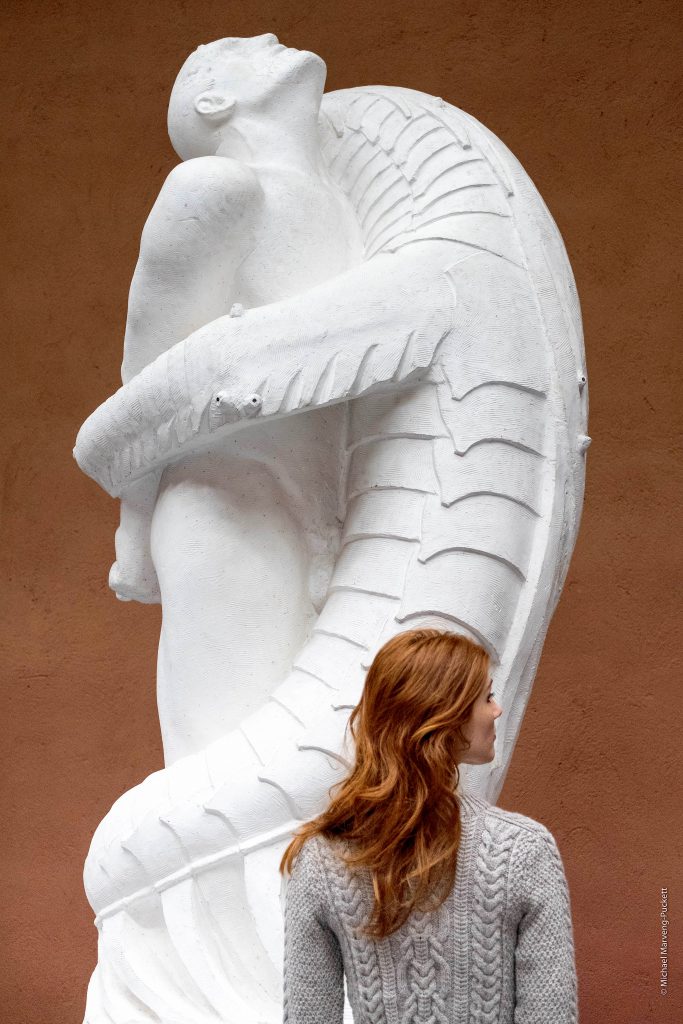 On Monday, I had a photoshoot at the Vigeland Museum, next to the Vigeland Park in Oslo. The brick building, with a majestic ceiling height, was built in the 1920’s in a Norwegian Neo Classical style. “The museum is the result of a unique contract between Gustav Vigeland and the city of Oslo signed in 1921: The Municipality agreed to build a studio, residence and future museum for the artist and his work, and in return Vigeland donated nearly all his works, previous and future, to the city”. It was with anticipation we (read my brilliant team: Photographer Eivind Røhne; Hair & Make Up Artist Sissel Fylling; Model Emma Ross; Michael; and me) were let in by one of the curators, as the museum is closed to the public on Mondays. During the day we had the chance to observe the curators at work and they us. As much as we admired their work, they enjoyed watching the beautiful garments being photographed and wondered which fashion magazine we were from. I explained that I designed handknit and that the photos were for the patterns and for the magazine Familien. Above you see gorgeous model Em, photographed by Michael in front of one of the plaster models for a sculpture to the park. Em is wearing Eira Pullover made for knit.wear Fall/Winter 2017, soon to be released in English in my Ravelry store.
On Monday, I had a photoshoot at the Vigeland Museum, next to the Vigeland Park in Oslo. The brick building, with a majestic ceiling height, was built in the 1920’s in a Norwegian Neo Classical style. “The museum is the result of a unique contract between Gustav Vigeland and the city of Oslo signed in 1921: The Municipality agreed to build a studio, residence and future museum for the artist and his work, and in return Vigeland donated nearly all his works, previous and future, to the city”. It was with anticipation we (read my brilliant team: Photographer Eivind Røhne; Hair & Make Up Artist Sissel Fylling; Model Emma Ross; Michael; and me) were let in by one of the curators, as the museum is closed to the public on Mondays. During the day we had the chance to observe the curators at work and they us. As much as we admired their work, they enjoyed watching the beautiful garments being photographed and wondered which fashion magazine we were from. I explained that I designed handknit and that the photos were for the patterns and for the magazine Familien. Above you see gorgeous model Em, photographed by Michael in front of one of the plaster models for a sculpture to the park. Em is wearing Eira Pullover made for knit.wear Fall/Winter 2017, soon to be released in English in my Ravelry store.
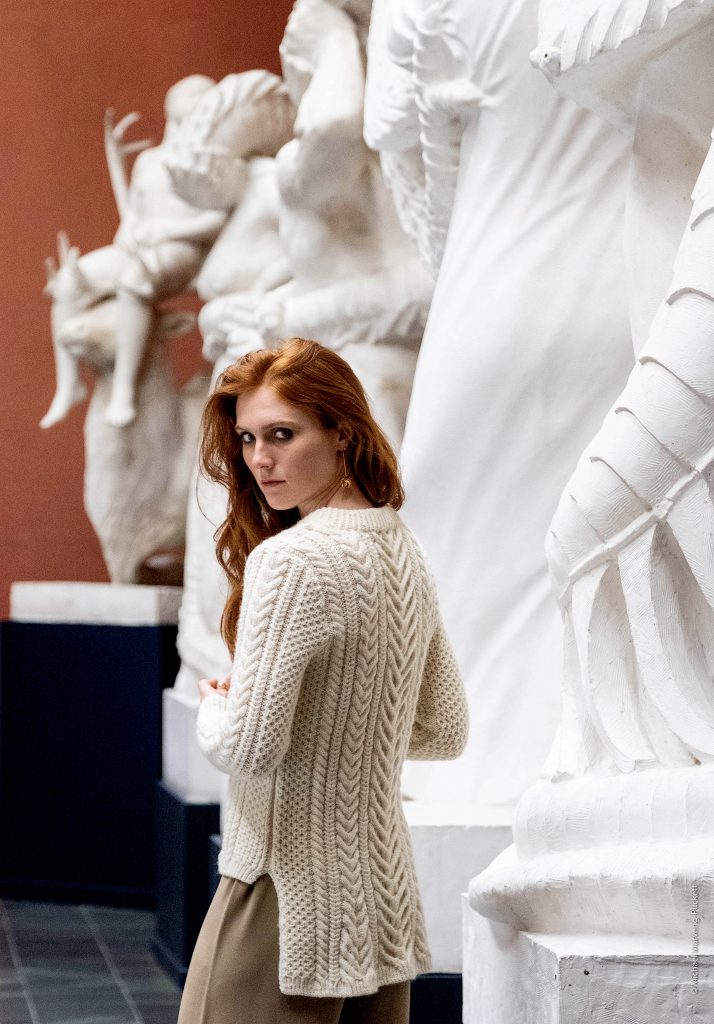 “Vigeland moved into the new building in 1924, living in the apartment on the top floor of the east wing. Here he resided and worked until his death in 1943. From the tower in this majestic red brick building he had a beautiful view towards the fields of Frogner, where his great project, the park, soon was to be reality.” We were guided into the Children’s room, were we would camp out all day. I am sure we enjoyed it as much as the children who usually visit that room! While Hair & Make up Artist Sissel was working her magic on Em, Eivind and I did a round in the museum. We picked two halls as for our shoot: Hall 9, which you see above and the Monolith Hall, which you see below. On the agenda was photographing a total of 10 garments: 4 new designs for Hillesvåg Ullvarefabrikk; 1 new design for the Norwegian magazine Familien: Nemetona; 4 returning designs from Interweave: Eira Pullover, Rørbye Cardigan, White Mountain Ruana and Andaman Top; 1 old design from my book: Tweedjakke with accessories: Duggdråpe Halser.
“Vigeland moved into the new building in 1924, living in the apartment on the top floor of the east wing. Here he resided and worked until his death in 1943. From the tower in this majestic red brick building he had a beautiful view towards the fields of Frogner, where his great project, the park, soon was to be reality.” We were guided into the Children’s room, were we would camp out all day. I am sure we enjoyed it as much as the children who usually visit that room! While Hair & Make up Artist Sissel was working her magic on Em, Eivind and I did a round in the museum. We picked two halls as for our shoot: Hall 9, which you see above and the Monolith Hall, which you see below. On the agenda was photographing a total of 10 garments: 4 new designs for Hillesvåg Ullvarefabrikk; 1 new design for the Norwegian magazine Familien: Nemetona; 4 returning designs from Interweave: Eira Pullover, Rørbye Cardigan, White Mountain Ruana and Andaman Top; 1 old design from my book: Tweedjakke with accessories: Duggdråpe Halser.
 “The museum opened in 1947, houses almost Vigeland’s entire production; sculptures in plaster, granite, bronze, marble, works in wrought iron, thousands of drawings, woodcuts and woodcarvings. In the museum you will find the original plasters to his famous busts and monuments, in addition to the plaster models to the sculptures in the Vigeland Park.” Above you can see Eivind in action, with me standing next to him and Michael just behind him. In the end we photographed nearly all of the garments, with the two exceptions you see above, in the Monolith Hall.
“The museum opened in 1947, houses almost Vigeland’s entire production; sculptures in plaster, granite, bronze, marble, works in wrought iron, thousands of drawings, woodcuts and woodcarvings. In the museum you will find the original plasters to his famous busts and monuments, in addition to the plaster models to the sculptures in the Vigeland Park.” Above you can see Eivind in action, with me standing next to him and Michael just behind him. In the end we photographed nearly all of the garments, with the two exceptions you see above, in the Monolith Hall.
The lizard in wrought iron is a model for the gates in the Vigeland Park and the most complicated of these wrought iron works Vigeland made. Their graphical presence added extra drama and was perfect for the Tweedjakke worn over Judith Bech’s wonderful skirt with a train. I was wearing the Patent Poncho, while Sissel – as you can see was cold – and wore her coat inside. To our surprise she did not cut Em’s hair this time. I had also borrowed jewellery by Kaja Gjedebo Design, as I usually do. There is no café at the museum so I had ordered catering from the nearby Eckers Cafe, with one delivery of drinks in the morning and one for lunch, so that we would not loose too much time looking for a nearby restaurant and wait for our lunch. That worked well and while we spent quite a bit of time to set up and prepare for the first garment, the remaining ones went quickly.
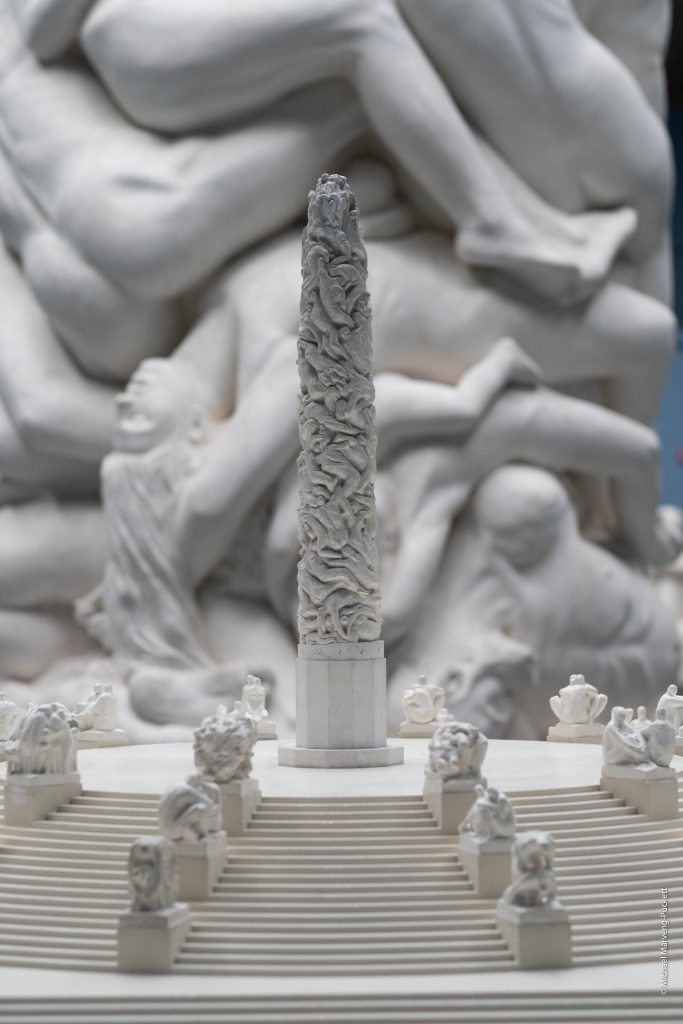 Michael assisted Eivind but also had the time to photograph some of the collection in the museum. Eivind had brought both extra lighting and a huge flash to make sure the lighting would be good enough. Above is the Monolith model for the park in front of the Monolith itself. “In the Monolith Hall stand several of the original plaster models to the 36 granite sculptures on the Monolith plateau, as well as the Monolith itself. This sculpture was carved in one piece (hence the name Monolith), but it was first modelled in clay, and then casted in plaster in three parts, as displayed in the museum today.”
Michael assisted Eivind but also had the time to photograph some of the collection in the museum. Eivind had brought both extra lighting and a huge flash to make sure the lighting would be good enough. Above is the Monolith model for the park in front of the Monolith itself. “In the Monolith Hall stand several of the original plaster models to the 36 granite sculptures on the Monolith plateau, as well as the Monolith itself. This sculpture was carved in one piece (hence the name Monolith), but it was first modelled in clay, and then casted in plaster in three parts, as displayed in the museum today.”
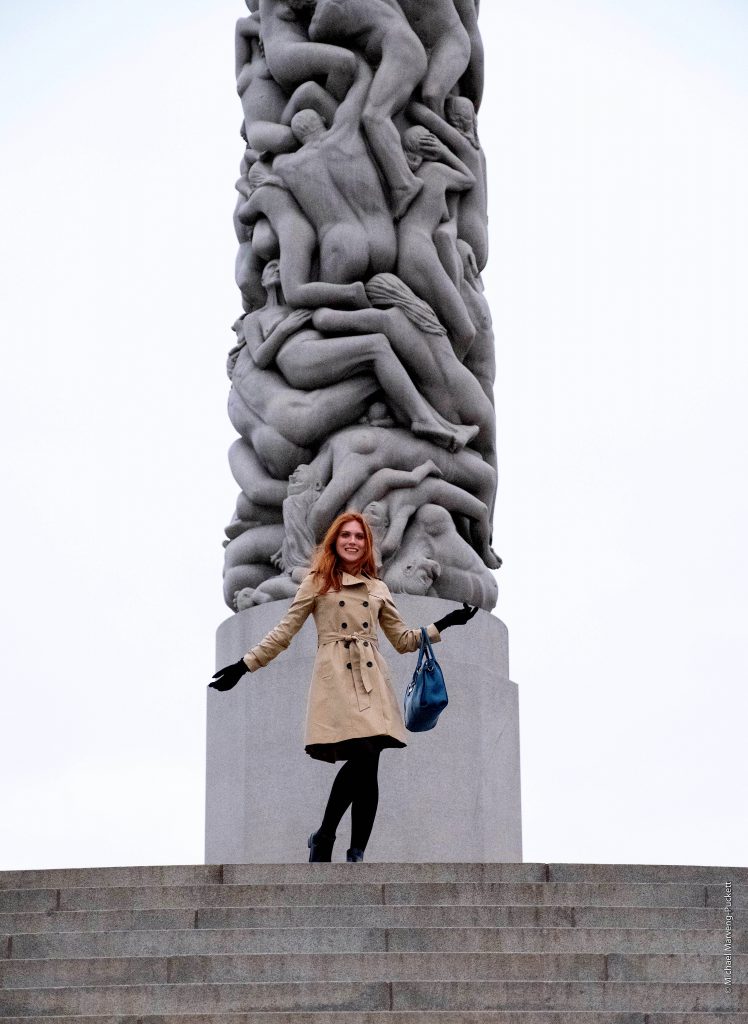 The Vigeland Museum is a popular venue for fashion shows, but also for concerts outside in the courtyard during the summer. The photoshoot was exhausting but also extremely rewarding and wonderful at the same time! After the shoot was a wrap – thanks to a brilliant team – and we had taken farewell with the curators and the security officer, we headed for the park, as Em has not had the time previously to see it. Above you see here in front of the Monolith in granite. Do visit both the park and the museum, when in Oslo, they are worth it. I will recapture our visit by choosing pictures from Eivind.
The Vigeland Museum is a popular venue for fashion shows, but also for concerts outside in the courtyard during the summer. The photoshoot was exhausting but also extremely rewarding and wonderful at the same time! After the shoot was a wrap – thanks to a brilliant team – and we had taken farewell with the curators and the security officer, we headed for the park, as Em has not had the time previously to see it. Above you see here in front of the Monolith in granite. Do visit both the park and the museum, when in Oslo, they are worth it. I will recapture our visit by choosing pictures from Eivind.
New Design: Nemetona
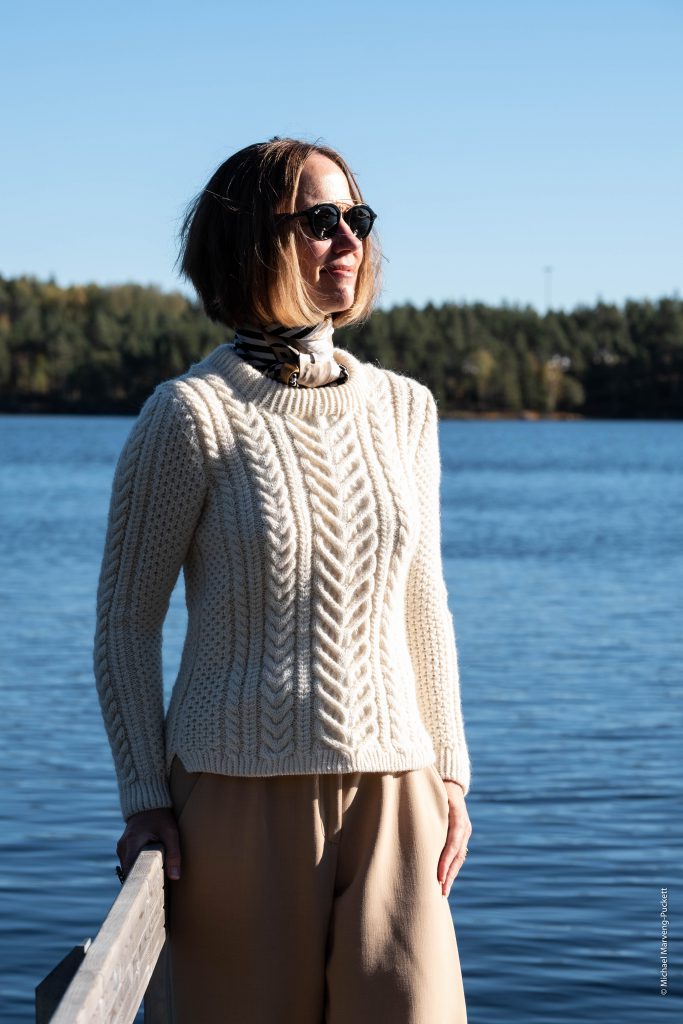 I am thrilled to show you my new design Nemetona, knitted in the divine The Fibre Co. Cumbria, that I chose as part of my payment for designing Stonethwaite for them. Nemetona and four new designs for Hillesvåg Ullvarefabrikk, plus returned designs from Interweave, will be professionally photographed on model Emma Ross by Eivind Røhne on Monday at the Vigeland Museum in Oslo. Nemetona is Celtic for goddess of all sacred places. Like a magical cable grove is each part of this pullover: Staghorn, Roman; and double cables are framed by Honeycomb pattern. The flowing longer back with its curved hem, creates a stylish contrast to the straight front. In these photos you see me wearing size Small with 2 cm/0.75″ positive ease, photographed by Michael at our nearby boat slip this autumn. Notice the new windmills that have popped up in the background.
I am thrilled to show you my new design Nemetona, knitted in the divine The Fibre Co. Cumbria, that I chose as part of my payment for designing Stonethwaite for them. Nemetona and four new designs for Hillesvåg Ullvarefabrikk, plus returned designs from Interweave, will be professionally photographed on model Emma Ross by Eivind Røhne on Monday at the Vigeland Museum in Oslo. Nemetona is Celtic for goddess of all sacred places. Like a magical cable grove is each part of this pullover: Staghorn, Roman; and double cables are framed by Honeycomb pattern. The flowing longer back with its curved hem, creates a stylish contrast to the straight front. In these photos you see me wearing size Small with 2 cm/0.75″ positive ease, photographed by Michael at our nearby boat slip this autumn. Notice the new windmills that have popped up in the background.
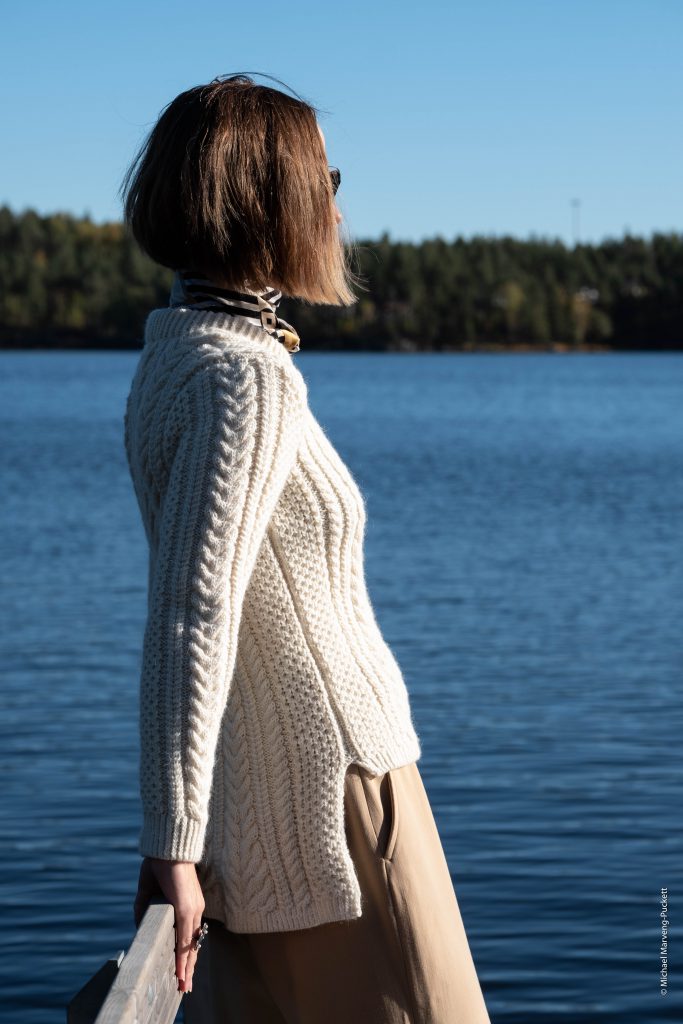 This time I wanted maximum texture and decided that even the sides should have cables in the shape of Honeycomb pattern. To give the side seam extra depth, I framed the Honeycomb stitches with a twisted stitch and a purl stitch in each side. I also choose to decrease inside the double cable to shape the longer back. The sweater can easily be modified to remove the longer back, if you wish.
This time I wanted maximum texture and decided that even the sides should have cables in the shape of Honeycomb pattern. To give the side seam extra depth, I framed the Honeycomb stitches with a twisted stitch and a purl stitch in each side. I also choose to decrease inside the double cable to shape the longer back. The sweater can easily be modified to remove the longer back, if you wish.
The Fibre Company Cumbria Worsted is made of 60% Merino Wool, 30% Brown Masham Wool, 10% Mohair on each 100 gram skein and has 218 meters/238 yards. I knitted the sample in White Heather 105 with a 20 stitches and 28 rows in stockinette stitch gauge measuring 10 cm/4″ square using 4 mm/US 6. I have graded the pullover from size XS to 2XL with bust circumferences of 84 to 126 cm/33 to 49.5″.
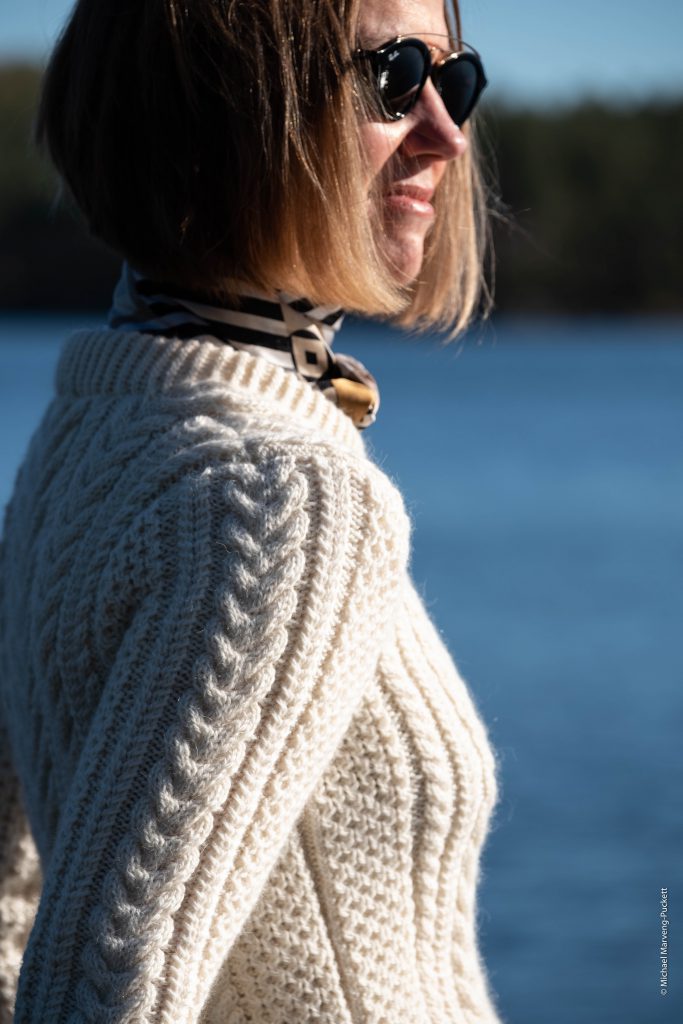 The sweater is knitted back and forth in pieces and then seamed. The neckband is worked in the round, double and folded down. The longer back has decreases in the double cable at the bottom. The vent edges are made with slipped stitches. Above you see a detail of the sleeve with its double cable, Roman cable dividers and Honeycomb pattern.
The sweater is knitted back and forth in pieces and then seamed. The neckband is worked in the round, double and folded down. The longer back has decreases in the double cable at the bottom. The vent edges are made with slipped stitches. Above you see a detail of the sleeve with its double cable, Roman cable dividers and Honeycomb pattern.
I plan to have the English pattern of Nemetona test knitted in my Ravelry group, set to begin 7th of January, and will release the pattern after the test knit is completed. The Norwegian pattern will be printed in the magazine Familien, the date will be confirmed later. But first you will see how it looks on Emma Ross.

